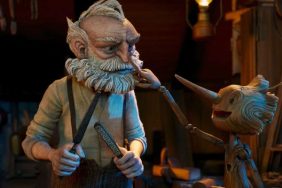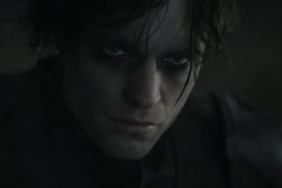
CraveOnline: Did the witch and the giant represent those stages of loss? Would they have been more-or-less intact in that other version?
Tomm Moore: Yeah, but the witch was different. Macha was more about acceptance. She was the last stage, and I think it was much more powerful to mush that whole denial thing into that character. It made her a more rounded character and better represented what was going on with the grandmother. So once we get on the idea that the mythological characters only needed to represent an exaggerated version of the real world characters, it became much clearer and the script became much leaner. We were able to strip out stuff, even if it was cool and fun. We were able to strip out stuff that was weighing the script down, I think, and make it very focused on what was going on for the human characters, as it were.
That approach, to use the fantasy characters as parallels with the “real” characters, that was very striking to me. It reminded me a bit of Peter Pan, and the way Captain Hook represents the father.
Hook and the Darlings, yeah, we talked about that and The Wizard of Oz. They do that a bit in The Wizard of Oz. We talked about it, just in general we thought that was the way to almost imagine, almost imagine that this whole story could be Ben using his mum’s stories as a way to understand what has gone on in his family. That was one way of looking at it.
“I always thought it was pretty cheap to have a real deep emotional moment and then cut away to some comic relief…”
It was an interesting approach. Usually I find at the end of those stories the audience is left to decide whether it was all real or a fantasy. Here, you seem to fall on, “Yeah, it was real.”
Yeah, that’s what we really did. We decided to really say that this is way more interesting, way more fun, to have it that now if a little kid sees a carving, they can imagine that that was a fairy that turned to stone. They’d have some sort of sense [of] that. When those stories take themselves seriously they’re way more interesting than pulling the punch and saying it was all a dream or something. Then the storyteller that we talked to early on, that I based a character on, I asked him if he believed in the stories, and he said that he believed that the people who told him the stories believed in fairies. So thought that was interesting.
You talk about not pulling punches and I think about something that’s missing from your movies that’s in a lot of animated movies, and I mean that in a good way. There really is “comic relief.” You don’t have wacky sidekick characters neutralizing the tension.
We did try to work a certain sense of fun in. The little fairy guys, the little musician guys and stuff, I hope that they would bring a certain amount of fun to it, but I think we don’t try to shy away from the heavy moments by cutting to them doing a funny face or something. Yeah. That always bugged me. I remember being annoyed by that in Disney movies and stuff. Not as a kid. As a kid I didn’t really notice that they were doing it, but as I got older I always thought it was pretty cheap to have a real deep emotional moment and then cut away to some comic relief as if you’re embarrassed by the fact you’ve gone there with the story. [Laughs.]








